
|
This article originally appeared in GammonVillage in 2000.
Thank you to Douglas Zare for his kind permission to reproduce it here.
|

|
Fundamental Equation of Luck and Skill
|
|
Backgammon is a game of luck and skill. To a casual observer, it may
appear to be all luck. As one gains more skill and familiarity with the
game, the depth of skill required to play well becomes
increasingly clear. The luck is still there, though, much to our joy and
frustration.
Sometimes one wants to strip away the luck. Is move A better than move
B? Is player X stronger than player Y? A proper respect for the luck in
the game is needed. Below, we will consider a method for
cancelling most of the luck in backgammon, and will apply it to
analyze a game between the computer programs Jellyfish
and Snowie,
both set on levels much stronger than I am.
I call the following equation the fundamental equation of games of luck
and skill:
|
Final − Initial = Net Luck + Net Skill
|
|
Final
|
refers to the final score. This might be +1 or −4 for a
money game, or 100% mwc (match winning chances) or 0% mwc
for a match.
|
|
Initial
|
refers to the starting equity or mwc of the situation
considered.
|
|
Net Luck
|
as outlined in "A Measure
of Luck," has average value 0 on each roll.
It also has average value 0 in each game or match.
|
|
Net Skill
|
is the difference in the total magnitude of the errors of the
players when compared with technically perfect play.
|
|
|
|

|
Variance Reduction in Rollouts
|
|
Variance reduction for rollouts is described in more detail in David
Montgomery's article in the February 2000 issue of Gammonline and in a preprint by
Fredrik Dahl, "Variance reduction for Markov processes using state space
evaluation for control variates." It is implemented in Jellyfish and
Snowie. I summarize it for comparison.
When rolling out a position (comparing play A with play B), we start with
a position (or two) whose equity we do not know. We might have Jellyfish
play both sides many times, so we hope that the Net Skill is 0, that
Jellyfish makes errors of equal magnitude from both sides of a
position. This may be unreasonable if one side's choices are easy and the
other side's are difficult, and must be reassessed with each
rollout. Let us rearrange the fundamental equation under the assumption
that Net Skill is 0: Initial = Final − Net Luck.
After rolling a position out, the final result is clear, but what we want
is different by the Net Luck. Over a long rollout, the average Net Luck will be close to 0, but we can do better than that. One way is to compute an Estimated Net Luck fairly, and subtract that from the result of the rollout. The estimate Initial ~ Final − Estimated Net Luck will be off by the difference between the actual Net Luck and the Estimated Net Luck, and with an accurate, unbiased estimate of luck, we will get an accurate, unbiased estimate of the equity of the position.
|
|

|
Variance Reduction of Skill
|
|
This is suggested in the above preprint by Fredrik Dahl.
Suppose two excellent players play. To find the Net Skill displayed, we
could use Snowie to estimate the errors made by each side. Unfortunately,
that method is biased. Suppose one of the players is Snowie: Snowie does
not play perfectly, but it would rate its own play as perfect, and would
reward those whose play resembles Snowie's rather than perfect
play. Instead, let us consider the fundamental equation applied to a
game. The initial position is even (we don't know who will win the first
roll) so the Initial equity is 0. Thus, we can rewrite the equation as
Net Skill = Final − Net Luck.
The final result of a rollout is a fair estimate for the initial equity,
but often not a good enough estimate. It would completely ignore the
effect of luck, and would be incorrect by the average Net Luck. The idea
of variance reduction is to compute an Estimated Net Luck fairly, and
subtract that from the final result instead. This is off by the average
amount of the Net Luck − Estimated Net Luck.
Snowie estimates the luck in a roll by estimating the equity of the best
play it sees after rolling, and subtracting the equity of the position
before rolling. This is a good estimate, and is equivalent to measuring
skill by summing up the errors compared with what Snowie thinks is the
best play. I have found this to be tremendously helpful, but because
Snowie does not estimate the equity perfectly, this method is biased, and
unsuitable for analyzing matches between players close to Snowie's level
or in positions where Snowie is less reliable. However, one can fix any
estimate of match winning chances to produce an unbiased estimate. An
evaluation as good as Snowie's may be corrected to eliminate most of the
luck in backgammon without bias.
Instead of comparing the evaluation of the apparently best play after
rolling with the estimated equity before rolling, just ask whether the
roll was above average or below average. This ensures that the estimated
luck will average to 0. Example: Suppose Snowie currently evaluates a
position as worth 0.2, but precisely half of the rolls would leave a
position Snowie believes is worth 1 and half of the rolls would leave a
position Snowie believes is worth −1. Snowie's estimate of the luck if one
rolls well is +0.8. Since the average is 0, the unbiased estimate
should be that the luck is +1. To be fair, one must evaluate the initial
position one ply deeper than the position after rolling.
|
|

|
Jellyfish vs Snowie
|
|
The following is a 1-point match between Snowie 3 (3-ply, tiny, 20%) and
Jellyfish 3 (Level 7, 1000). This was the first match I tried. Most plays
are straightforward, but not all: Jellyfish primes Snowie, obtains a
racing lead as Snowie's board crashes, and bears in safely. Afterwards,
I performed a variance reduction using Snowie 3 set on 1-ply evaluation.
All of the evaluations are in the unusual units of match equity, which
is +1 for a won match and −1 for a lost one. The perspective is always
that of Jellyfish, so a bad roll for Snowie shows up as positive
luck. Note that the evaluation for a given move does not
always agree with the average for the next move, even when these
correspond to the same position. Average is the higher ply
evaluation.
|
Jellyfish
|
Snowie
|
|
1
|
5-2: 13/8, 24/22
Average/Evaluation/Luck:
0.000 / 0.012 / +.012
|
6-3: 24/15
A/E/L: 0.010 / 0.057 / +.047
|
|
2
|
3-3: 13/10*(2), 8/5(2)
A/E/L: 0.054 / 0.284 / +.230
|
2-3: B/22, 24/22
A/E/L: 0.283 / 0.261 / −.022
|
|
3
|
4-2: 24/20, 22/20
A/E/L: 0.255 / 0.266 / +.011
|
2-1: 6/3
A/E/L: 0.265 / 0.307 / +.042
|
|
4
|
3-2: 13/10, 13/11
A/E/L: 0.308 / 0.257 / −.051
|
4-2: 8/4, 6/4
A/E/L: 0.256 / 0.289 / +.033
|
|
5
|
3-2:
|
|
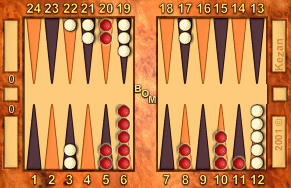 |
|
Red to play 3-2
R: 137, W: 154
|
|
Jellyfish
|
Snowie
|
|
5
|
3-2: 11/8, 6/4
SW Tiny, 20% and SW 1-ply prefer 11/8 10/8, but SW Huge, 100% agrees with this play.
A/E/L: 0.282 / 0.238 / −.044
|
5-4: 13/8, 13/9
A/E/L: 0.226 / 0.307 / +.081
|
|
6
|
3-1: 10/7, 8/7
A/E/L: 0.307 / 0.261 / &minus.046
|
6-3: 13/10, 9/3
0.250 / 0.343 / +.093
|
|
7
|
4-1:
|
|
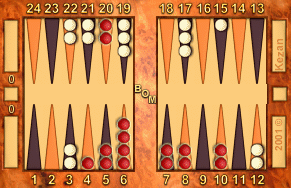 |
|
Red to play 4-1
R: 128, W: 136
|
|
Jellyfish
|
Snowie
|
|
7
|
4-1: 20/15*
Holding the anchor with 8/4 8/7 is preferred by SW Huge, 100%
(by 0.1% mwc) and by Tiny, 20%, though 1-ply rates them as equal.
A/E/L: 0.362 / 0.238 / −.124
|
1-2: B/23, 22/21*
A/E/L: 0.232 / 0.137 / &minus.095
|
|
8
|
4-1: B/20
A/E/L: 0.161 / 0.284 / +.123
|
5-4: 21/12
A/E/L: 0.277 / 0.386 / +.109
|
|
9
|
1-1: 15/13*, 10/9(2)
A/E/L: 0.391 / 0.510 / +.119
|
3-2: B/22, 23/21
A/E/L: 0.491 / 0.448 / −.043
|
|
10
|
2-1:
|
|
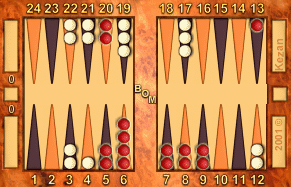 |
|
Red to play 2-1
R: 135, W: 147
|
|
Jellyfish
|
Snowie
|
|
10
|
2-1: 13/11, 6/5
SW Huge, 100% prefers 6/4* 6/5 by 0.06% mwc, though Tiny, 20%
agrees with not hitting. 1-ply rates them as equal.
A/E/L: 0.455 / 0.464 / +.009
|
6-3: 21/12
A/E/L: 0.458 / 0.420 / −.038
|
|
11
|
4-2:
|
|
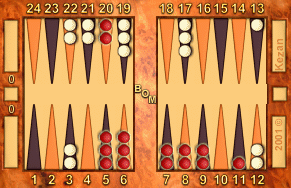 |
|
Red to play 4-2
R: 132, W: 138
|
|
Jellyfish
|
Snowie
|
|
11
|
4-2: 11/7, 6/4
All Snowie levels preferred 11/5, Huge, 100% by 0.20% mwc.
A/E/L: 0.414 / 0.374 / −.040
|
1-4:
|
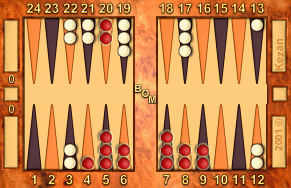 |
|
White to play 1-4
R: 126, W: 138
|
|
Jellyfish
|
Snowie
|
|
11
|
|
1-4: 22/21*, 8/4
SW Huge, 100% prefers 22/21* 12/8 by 0.17% mwc
A/E/L: 0.351 / 0.181 / &minus.170
|
|
12
|
3-2: B/20
A/E/L: 0.231 / 0.266 / +.035
|
3-2: 13/10, 12/10
A/E/L: 0.300 / 0.374 / +.074
|
|
13
|
4-2: 7/3*, 5/3
A/E/L: 0.409 / 0.294 / −.115
|
5-4: B/21, 13/8
A/E/L: 0.271 / 0.047 / −.224
|
|
14
|
5-2: 20/13
A/E/L: 0.077 / 0.117 / +.040
|
5-5:
|
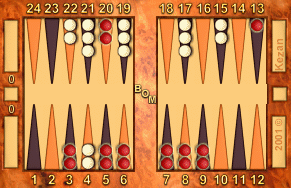 |
|
White to play 5-5
R: 129, W: 122
|
|
Jellyfish
|
Snowie
|
|
14
|
|
5-5: 8/3(3), 6/1
Snowie flings the dice across the room. This worst possible roll is
almost a full point behind 6-6.
A/E/L: 0.112 / 0.303 / +.191
|
|
15
|
3-4: 13/6
A/E/L: 0.314 / 0.316 / +.002
|
3-1: 4/1, 3/2
A/E/L: 0.310 / 0.219 / −.091
|
|
16
|
5-4: 20/11
A/E/L: 0.227 / 0.181 / −.046
|
4-1: 6/2, 6/5*
A/E/L: 0.193 / 0.228 / +.035
|
|
17
|
5-5:
|
|
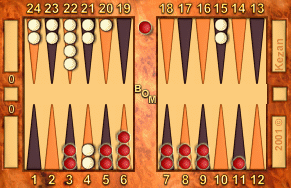 |
|
Red to play 5-5
R: 118, W: 93
|
|
Jellyfish
|
Snowie
|
|
17
|
5-5: B/20*, 11/1, 6/1
All levels of Snowie prefer B/20* 11/6 7/2(2), Huge, 100% by 0.62%
mwc.
A/E/L: 0.284 / 0.618 / +.334
|
2-2: B/21, 10/8(2)
A/E/L: 0.590 / 0.468 / −.122
|
|
18
|
5-3: 20/12
A/E/L: 0.526 / 0.517 / −.009
|
1-2: 8/5
A/E/L: 0.499 / 0.546 / +.047
|
|
19
|
6-5: 12/1
A/E/L: 0.626 / 0.593 / −.033
|
3-4: 8/1
A/E/L: 0.607 / 0.654 / +.047
|
|
20
|
5-3: 8/3, 8/5
A/E/L: 0.702 / 0.654 / −.048
|
3-1: 5/2, 3/2
A/E/L: 0.686 / 0.763 / +.077
|
|
21
|
6-1: 7/6, 7/1
A/E/L: 0.761 / 0.695 / −.066
|
3-3: 21/9
A/E/L: 0.707 / 0.634 / +.073
|
|
22
|
3-2: 6/1
A/E/L: 0.634 / 0.563 / −.071
|
5-2: 9/4, 3/1
A/E/L: 0.548 / 0.589 / +.041
|
|
23
|
5-1: 6/5, 6/1
A/E/L: 0.589 / 0.499 / −.090
|
6-3: 21/12
A/E/L: 0.432 / 0.386 / +.046
|
|
24
|
6-6:
|
|
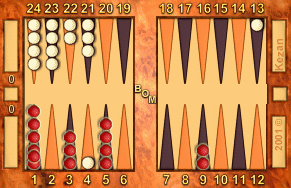 |
|
Red to play 6-6
R: 53, W: 63
|
|
Jellyfish
|
Snowie
|
|
24
|
6-6: 9/3(2), 5/O(2)
A/E/L: 0.451 / 0.932 / +.481
|
3-4: 12/5
A/E/L: 0.909 / 0.929 / +.020
|
|
25
|
6-6: 5/O(2), 3/O(2)
A/E/L: 0.910 / 0.991 / +.081
|
1-2: 21/19, 2/1
A/E/L: 0.994 / 0.995 / +.001
|
|
26
|
4-3: 3/O(2)
A/E/L: 0.998 / 0.997 / −0.001
|
5-5: 19/4 5/O
A/E/L: 0.998 / 1 / +.002
|
|
27
|
3-3: 3/O 1/O(3)
A/E/L: 1 / 1 / 0
|
1-2: 3/O
A/E/L: 1 / 1 / 0
|
|
28
|
1-5: 1/O(2)
A/E/L: 1 / 1 / 0
|
3-3: 4/1(3) 3/O
A/E/L: 1 / 1 / 0
|
|
29
|
4-5: 1/O
A/E/L: 1 / 1 / 0
|
|
|
|

|
Evaluations
|
|
From the evaluations of Snowie Huge, 100%, it believed that Jellyfish
erred by a total of .98% mwc, and that Tiny, 20% erred by 0.17% mwc, so
it would rate Snowie's play as stronger by 0.8% mwc, and say that
Tiny, 20% should win 50.2% of the time.
The total estimated luck for Jellyfish is +0.865. The outcome was +1, so
the estimated net skill was that Jellyfish was stronger by +0.135, or
6.8% mwc.
Is this accurate? No, but it is much closer than saying that Jellyfish
will win all the games since it won the first one. We performed variance
reduction, not variance elimination. This result is probably further from
the correct value than would be obtained by using the biased analysis of
Snowie directly. There is still some noise on top of the signal, but it
will take a much shorter sequence of matches for this noise to be
essentially 0 than if one were not to try to cancel out the luck. My guess
is that there is a factor of 1/5 to 1/10 as much noise as before, and that this
would be reduced much more by using 2-ply or 3-ply evaluations.
One should keep in mind that the level of skill is also subject to change, since the
player might be better or worse at handling blitzes, backgames, or holding games. This may
be viewed as another source of noise that is not affected by the variance reduction. Even
within a type of game, a player might make more or fewer errors at random. So even with a
perfect estimate of the Net Luck, one would need a few games of each type to
estimate the
average skill displayed.
|
|

|
Hedged Backgammon
|
|
One can use the idea of variance reduction to remove much of the luck of backgammon as one
plays, although it is awkward at the moment to do this for two human players in real time.
Play a normal match or money game, but at the end, pay the unbiased estimate of your luck
(or receive it if you were unlucky). This is equivalent to making a series of fair
side-bets suggested by a bot's evaluation: Each player bets that he or she
will appear unlucky to the bot. By betting against their own luck, both players will
experience smaller swings, and since the bets are fair they will still have the same
incentive to play well. The payment is the estimated Net Skill.
If the example match above were hedged, then Jellyfish would collect 0.135
times the stakes from Snowie: 1 for winning − 0.865 in side bets.
An odd effect of hedging would be that one would probably owe something after winning
a short blitz—it is hard to blitz correctly, and easy to be blitzed correctly, so one's
luck while blitzing usually exceeds the point won. Would it be worthwhile to avoid
positions like this which are hard to play? As with regular backgammon, yes, but only if
avoiding the hard position is less of an error than one expects to make while playing
it.
What difference does it make if the bot whose evaluations are used is stronger? The
quality of the estimate of Net Skill is beneficial but not very important as
long as it is unbiased. Bots which play better will tend to have better estimates, which
means that
there will be less noise added to the payoffs. If one plays through positions that
the evaluator does not understand well, there may be larger variations. These
sources will be added to the natural variations in the actual displayed skill. Reducing
the noise from the estimate a few percent by using rollouts would be like adding more
insulation to the walls without closing the window. For intermediate players and above,
though, the error in the estimate of Net Skill is nowhere near the
oscillations from the
unhedged luck of the dice.
Suppose I play 25 1-point matches with a bot stronger than I am by 10% mwc, i.e., it
will win 3 out of 5 matches. It should win 15 of the 25 matches, but due to variations
in luck, 15% of the time it will win at most 12, and 15% of the time it will win 18 or
more matches. There is almost a 1/3 chance that the estimated skill difference would be
off by more than 12%. By the FIBS ratings formula, rather than being ahead 350 rating
points the bot might appear to be 825 points ahead or 65 points behind.
What happens if we hedge the matches? That depends on a few things. I believe the
following are plausible assumptions:
Suppose our Net Skill varies by +−10%, that is, half the time we play equally
well, and half of the time I throw away 20% more equity than the bot. Suppose the bot's
estimate is off by +−10% each time. Then 88% of the time the adjusted score would be as
though the bot won between 14 and 16 matches, between 215 rating points and 505 point
ahead, and over 99% of the time the hedged score would be as though the bot won between 13
and 17 matches. To achieve the same level of accuracy without hedging, we would need to
play more than 10 times as many matches.
Much as I have enjoyed playing hundreds of matches and money games against Jellyfish and
Snowie to see if I learned anything from reading a backgammon book, variance reduction
of skill is the feature I would most like to see in the next editions of backgammon
programs.
|
|
© 2000 by Douglas Zare.
Douglas Zare is a mathematician and backgammon theorist. He writes a monthly column at GammonVillage on the theoretical aspects of backgammon. His web site is douglaszare.com.

Return to
: Articles by Douglas Zare
: Backgammon Galore
|








![]()







